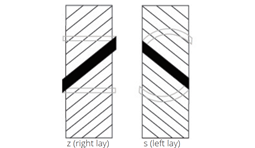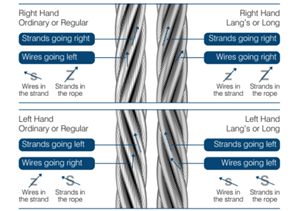Scope.
Steel wire ropes are regularly referred to as being left or right hand lay and being ordinary/ regular or Lang’s. More recently the direction and type of rope lay has been referred to using a combination of the letters S and Z, which has been new to some rope users. The direction and type of lay is an important feature of any stranded wire rope and determines key rope characteristics e.g. fatigue, wear, crush resistance, etc. and can affect the safety of the different ropes in-service. This bulletin aims to provide background information to support the user when selecting a type of rope lay for an application.Direction of Rope Lay.
The direction of rope lay is determined by the direction the individual strands within the rope are twisted around the core. The picture illustrates if the strands are going upwards to the left, this is a left-hand rope and if the individual strands are going upwards to the right, this is a right-hand lay. The direction of rope lay is also referred to using the letters S and Z, by placing the letters over the rope the left-hand becomes S lay and the right-hand becomes Z lay.

Type of Rope Lay.
An Ordinary/Regular lay rope has the individual wires within the outer strands twisted in the opposite direction to the strands twisted around the core. This results in the individual wires running along the axis of the rope.

The illustration above shows the individual wires within the outer strands twisting in an S (left) direction and the outer strands twisting around the core in a Z (right) direction. The lay of this rope is therefore referred to as sZ (right-hand ordinary lay - RHOL or righthand regular lay - RHRL) the smaller letter first being the direction of the wires in the strands and the second larger letter being the direction of the strands in the rope.
A Lang’s lay rope has the individual wires within the outer strands twisted in the same direction as the strands twisted around the core. This results in the individual wires
running across the axis of the rope.
The illustration shows the individual wires within the outer strands twisting in a Z (right) direction and the outer strands twisting around the core in a Z (right) direction. The lay of this rope is therefore referred to as zZ (right-hand Lang’s lay - RHLL) the smaller letter first being the direction of the wires in the strands and the second larger letter being the direction of the strands in the rope.
| Alternative descriptions for the direction and type of rope lay | ||
| RHOL (Right Hand Ordinary Lay) | RHRL (Right Hand Regular Lay) | sZ |
| LHOL (Left Hand Ordinary Lay) | LHRL (Left Hand Regular Lay) | sZ |
| RHLL (Right Hand Lang's Lay) | zZ | |
| LHLL (Left Hand Lang's Lay) | sS | |
The same diameter and construction of ropes (i.e. 28mm 6 x 19S-IWRC) manufactured in ordinary lay and Lang’s lay, have exactly the same number of wires, of the same diameter and therefore both ropes have the same steel area and strength.
Advantages of a Lang's Lay.

Bend fatigue, as a wire rope passes over sheaves, both the wire rope and the individual wires within the rope are subjected to bending. Since the individual wires within an ordinary lay rope are on the same axis as the rope, the same degree of bend is imposed on the crowns of the outer wires. Comparing the length of individual wires exposed from valley to valley, as illustrated below, the wires are significantly longer in the Lang’s lay rope. Therefore, the bending of a Lang’s lay rope results in less axial bending of the outer wires and an increase in bending fatigue performance. Additionally, the worn crown together with the shorter exposed length, allows the wire to spring away from the rope axis, further reducing the bend fatigue performance of an ordinary lay rope. Alternative descriptions for the direction and type of rope lay Right hand ordinary lay (RHOL) Right hand regular lay (RHRL) sZ Left hand ordinary lay (LHOL) Left hand regular lay (LHRL) sZ Right hand Lang’s lay (RHLL) zZ Left hand Lang’s lay (LHLL) sS Advantages of a Lang’s lay.

Resistance to wear, wires within an ordinary lay rope are subject of higher unit pressure which increases the rate of wear on both the wires within the rope and the contacting surfaces of the sheaves and drums. Therefore, the larger exposed surface area of the individual wires within a Lang’s lay rope provides the Lang’s lay ropes with better wear resistance and resistance to abrasion.
Disadvantages of a Lang's Lay Rope.
Resistance to crushing, Lang’s lay ropes are more sensitive to crushing and less robust.Rotational characteristics, Lang’s lay ropes generate a higher torque moment due to the wires and strands being twisted in the same direction and have an increased tendency to turn (untwist) in-service and therefore single layer Lang’s lay construction ropes, e.g. 6 & 8 strand, should only be used when both ends of the rope are fixed, prevented from rotating.
Further guidance is available at contact@bridon-bekaert.com
Reference: TB.004 Ed.1 Dec 2021